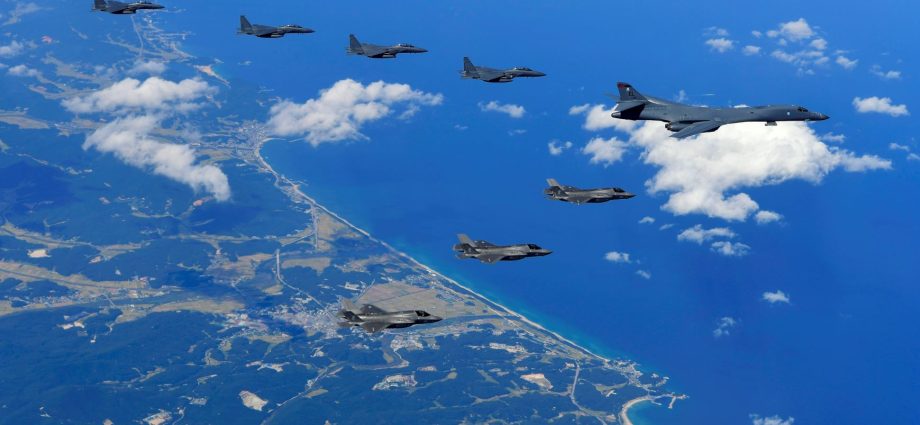China’s November 2013 declaration of an Air Defence Identification Zone (ADIZ) over the East China Sea was rebuked by the United States and its Northeast Asian allies.
It was viewed as a counter-hegemonic geopolitical move for control over contested islands and as the first of multiple declarations designed to expand Beijing’s regional influence and reinforce dubious maritime sovereignty claims — particularly over the South China Sea.
A decade on, Beijing appears more focused on destabilizing rival states’ existing ADIZs than establishing any additional zones of its own. Taiwan’s zone faces increased Chinese violations, especially during moments of heightened tension. Japan and South Korea have also faced repeated Chinese violations of their ADIZs.
These violations are regularly publicized in defense white papers, government social media accounts and news reports. Enforcing these zones has led to costly defense procurement strategies, such as investment in air-to-air refueling capabilities.
Viewing East Asian ADIZs through the narrow “rise of China” lens provides only partial understanding. Making full sense of the issue requires a broader regional focus that acknowledges the ambiguity of these zones, and the complex interactions between actors involved in establishing, enforcing, challenging or complying with them.
Despite dangers of escalation and miscalculation, there is currently no formal agreement on how ADIZs operate in the region.
The Convention on International Civil Aviation defines an ADIZ as a “special designated airspace of defined dimensions within which aircraft are required to comply with special identification and/or reporting procedures.”
But the meanings ascribed to ADIZs have changed significantly over time, to become increasingly embroiled in maritime and territorial disputes. Divergences in perceptions of risk and opportunity have led to debates over ADIZs’ legality, function and performance.
East Asian ADIZs may not be the explicit “land grabs” claimed in 2013, but they are still important because they are “grey volumes” — complex three-dimensional aerial spaces whose meanings are contested.

They are legally ambiguous due to their uncertain status in international law and because, unlike typical land borders, they produce areas of partial sovereignty that overlap with other states’ ADIZs.
They are also functionally complex because their original usage to detect airborne nuclear threats during the Cold War has been complicated by fears of terrorism and rival maritime territorial claims. The performance of these zones is multi-faceted due to the range of state and non-state actors involved, each with their distinctive approaches. These divergences have already led to contestation and pose risks of miscalculation.
The initial ADIZs were set up around South Korea, Japan and Taiwan in the 1950s. These reflect the United States and allied nations’ fears of Moscow and Beijing’s new air capabilities. But these original zones neither overlapped nor corresponded with competing maritime territorial claims. Their defensive, technical orientation meant that they were accepted by littoral states as a legitimate response to changing technologies.
But consensus over these zones has broken down after the Cold War. East Asian states have expanded — or set up — their zones to reinforce their claims while opposing any suggestion that rivals be permitted to do the same. For example, in 2010 Japan expanded its zone to slightly overlap with the Taiwanese ADIZ, a move opposed by Taipei.
Three years later, when Beijing’s ADIZ incorporated the Socotra Rock — possession of which is disputed by China and South Korea — Seoul responded by first opposing the Chinese ADIZ and subsequently extending its own zone over the rock. Among contemporary Chinese, Japanese, South Korean and Taiwanese ADIZs, only the latter two do not currently overlap.
ADIZs are challenging to set up and enforce. This is partly because of the extremely costly identification systems and intercepting aircraft required to monitor and police these zones. This is likely one reason why Taiwan and Japan do not always scramble aircraft to meet Chinese violations of their ADIZs and why North Korea has never established one.
States are not the only actors involved in the navigation of these spaces. Commercial airlines and other non-state actors are also impacted by the burdensome requirements of complex overlapping zones. In 2015, a Laotian airliner reportedly complied with China’s request to leave its ADIZ after failing to comply with its requirements.
While the United States, South Korean and Japanese air forces violated the newly announced Chinese zone in 2013, Washington and Seoul advised their civilian airlines to comply with the procedures. Only Japanese civilian airliners are non-compliant. These inconsistencies further highlight real intricacies around the performance of these zones.

Redirecting the use of ADIZs back to defensive purposes, such as nuclear security and counterterrorism, is unlikely as long as policymakers believe that they are effective for asserting sovereignty over the sea or land below.
But a modest regional agreement standardizing the operating procedures of East Asian ADIZs could begin to re-establish consensus on their performance, thereby reducing risks of escalation or miscalculation.
With an expected return of trilateral summit diplomacy between China, Japan and South Korea in 2023, the time may be right to begin discussions on this issue. East Asian states could look to the ongoing China-ASEAN dialogue on a South China Sea Code of Conduct as a model for such an agreement.
Alexander M Hynd is a PhD candidate at the School of Social Sciences, University of New South Wales. Daniel Connolly is Associate Professor at the Division of International Studies, Hankuk University of Foreign Studies.
This article was originally published by East Asia Forum and is republished under a Creative Commons license.

